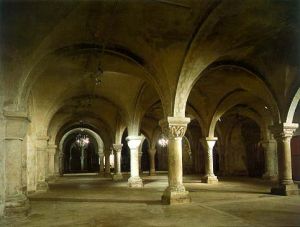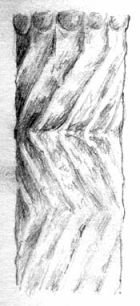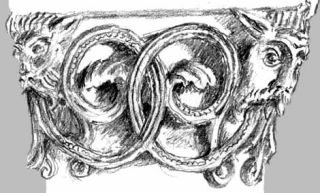Chapter 15
- (Granser at Good Mercy; Cambry; the crypt; "Stoan"; Greanvine)
- Turned loose again by Goodparley, Riddley heads for Cambry. Along the way, he encounters Granser, Goodparley's former master, presumed dead but now working as a charcoal burner.
- Entering Cambry, Riddley and the dogs feel a mystical pull to the ruins of Canterbury Cathedral. For the first time since his unsuccessful tel, Riddley has a visionary experience—this time not of Eusa but of a female divinity, associated with fertility, night, and the stone ruins. Riddley makes up his first original story, about the secret life of stones. He also finds a mysterious carved face in the ruins, which he calls "Greanvine," and which seems to be related somehow to some anti-Goodparley graffiti. A clue that Lissener may be in trouble (the return of the other half of the dog pack) sends him back toward Fork Stoan.
- Nearly all the "action" in the Cambry section takes place in Riddley's mind as he thinks back on recent events and free-associates on a flood of images. Unlike the other places he has visited, there seems to be no particular reason why he had to go there at this particular time; the things he finds do not advance the plot so much as realign his thoughts. In effect, by going to the geographic "senter" (as Cambry is called in Fools Circel 9wys), Riddley has "centered" himself in the meditative sense, clearing the mind to make room for insight. (Note that he appears to be the only human being in the town.) This also brings a new sense of equanimity: "LOSE IT ... LET GO ... THE ONLYES POWER IS NO POWER" (167:5).
- (153:27) "Cheer up it may never happen"
This is a traditional British way of telling someone to stop looking so depressed.
See Places.
- (154:30) "the way the lite come acrost the feal you cud see some kynd of old pattren unner neath of the new furrows. Strait lines and circles from time back way back."
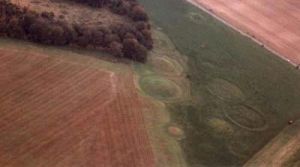
Barrows -- burial chambers in the form of circular mounds and sometimes straight lines -- are still visible in the ground of England after six thousand years.
- (155:3) "Wo Jooper! Go roun Klisto!"
The oxen are named after Jupiter and its moon Callisto.
- (155:16) "When we come to the Ring Ditch the stannings of the Power Ring stood up wite agenst the dark like broakin teef"
Whatever made the Ring Ditch was presumably built after our time. The old town center of Canterbury is surrounded by a roughly ring-shaped (but incomplete) wall from the 14th century, but it's hard to see how it would leave a ditch or "stannings," and it is not nearly as big as what's shown on Riddley's map.
- (158:33) "I fealt like that Power wer a Big Old Father I wantit it to do me like Granser done Goodparley I wantit it to come in to me hard and strong long and strong. Let me be your boy, I thot"
This is the first and only mention of a patriarchal god and the idea is clearly a novelty to Riddley. The Eusa Story does not include a Big Old Father, but Riddley's use of capital letters is a sure sign that he means it in a religious sense (like Power, No., or Trubba).
Note that Riddley, Goodparley, and Lissener all have fathers who were killed: Riddley's by accident; Lissener's by Goodparley; Goodparley's by pirates, and his surrogate father by Goodparley.
Also note the use of the word "boy," more explicitly than earlier, to refer to submissive sex.
- (159:6) "I knowit Cambry Senter ben flattent the werst of all the dead town senters it ben Zero Groun it ben where the wite shadderd stood up over every thing"
Given the small size of Kent (see places), it would seem unlikely that separate nuclear bombs were dropped on each of the "dead towns"; but Riddley has mentioned seeing white shadows in the other towns, which are only found near the heart of a blast. Then again, we don't know how weapons might have advanced (so to speak) between the modern day and Bad Time.
- (159:28) "the woman dollys they hang over where a womans bearthing. Which them dollys theyre the same shape as the woman cakes they bake"
This is one of the few references in the book to female customs. His lack of knowledge about or apparent interest in the details (i.e. what the cakes are for), and his lack of contact with any woman but Lorna, imply that Riddley lives in a sexually segregated world and takes this for granted.
- (160:3) "Shes what she is ..."
This paragraph is a quote from Lorna's "Why the Dog Wont Show Its Eyes".
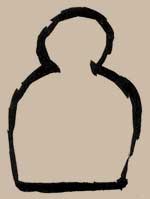
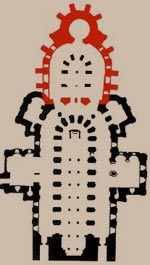
The "dolly" shape Riddley draws here, as RH points out, looks quite like the silhouette of certain sheela-na-gigs. It's also the outline of the main part of Canterbury Cathedral, either the choir and nave or the crypt beneath; the dogs are running on the ground where the cathedral used to stand.
- (160:12) "its a littl to the Wes of that which its unner neath the groun"
This is the cathedral's western crypt. It was built by the Normans in the 12th century, and later extended to the east in a different style. Presently the crypt is only a few steps below ground level, with sunlight entering through small windows, but it could have been further buried by rubble.
- (161:15) "it wer stoan trees growing unner the groun .... Roun trunks of stoan and each 1 had 4 stoan branches curving up and over"
See this photo of the columns and arches of the crypt to get an idea of what Riddley is seeing. The interleaving of arches is almost mathematically regular, but with the texture of the stone and the variation between columns, it still suggests a living forest.
- (162:26) "Fealing the carving unner my hans it wer like shaller runnels cut in the stoan"
This drawing from the crypt shows the zigzag carvings on one of the columns; each of the columns is decorated differently.
- (163:11) "Stoan"
This is the last story with a title in the book. Riddley started the book by repeating shared myths about humanity; this is something very different. In fact, the progression of stories throughout the book follows a familiar literary trend, moving from the cosmologic/epic (prehistoric myth) to the heroic (classical myth) to the personal and then the internal (modernist fiction):
"Hart of the Wood": the fall of humanity in the distant past. Everyone knows this story.
"Why the Dog Wont Show Its Eyes": the fall of humanity, continued. Everyone used to know this story, but now only Lorna does.
"Eusa Story": the fall of humanity as played out in the life of one special man.
"The Lissener and the Other Voyce Owl of the Worl": a mythic fragment without time or place, with Lissener (who may be the author) in a central role.
"The Bloak As Got on Top of Aunty": a tall tale about a man in a familiar place. Made up by a showman without any particular intentions.
"Stoan": A fragment without time, place, or characters, which came to Riddley from nowhere.
- (164:12) "theres a stoan self of your self in the groun and walking foot to foot with you"
The same image occurs in Hoban's earlier novel Kleinzeit.
- (164:29) "Its jus only stoan men walking unner the groun like that. Women have some thing else"
Another instance of Riddley referring to women's secrets with no apparent curiosity.
- (165:18) "that face with the vines and leaves growing out of the mouf"
A Green Man, and although Riddley doesn't say so, there are several stone carvings very much like this in the cathedral (as well as other styles of Green Man without the vines). In fact, one of the columns with the zig-zag pattern mentioned above is topped with a design of startled-looking, rather lion-like heads disgorging thick curling vines, shown in this drawing.
- (167:36) "It were Greanvine. Carvit out of wood ... The back of it flat and the front of it ful roundit"
Green Man designs are often found ornamenting the ends of wooden benches, or on wood reliefs fastened to the undersides of prayer seats (misericords).
- (168:16) "Becaws a woman is a wooman aint she. Shes the 1 with the woom"
Another use of deliberately false etymology. Woman really comes from the Old English wifman (wife-man or female-person), while womb comes from an unrelated word for belly; but Riddley's spelling brings out an obvious fact.
